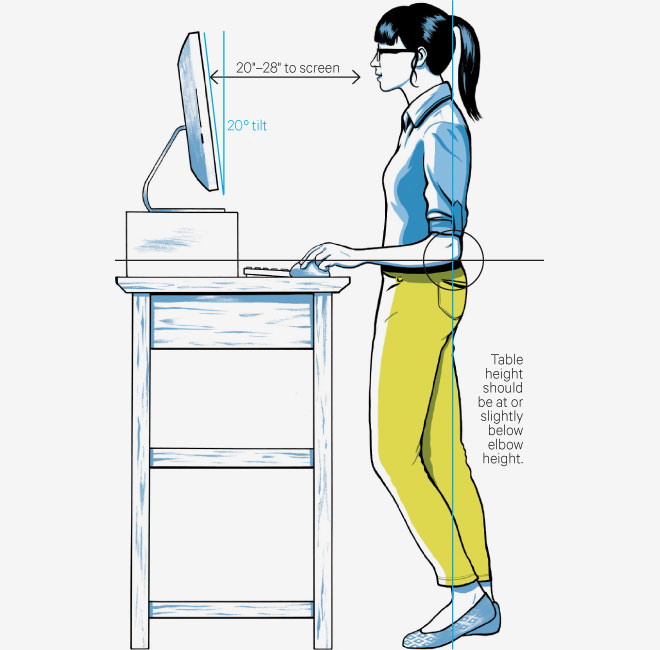Photo courtesy of Wired.
Health specialists have been quick to tell us time and again that sitting is the new smoking when it comes to what kills us. Between the 12 hours we spend sitting at a computer and watching TV, plus the 8 hours we’re sleeping, that’s approximately 20 hours we spend each day without motion.
In the last decade, standing desks have become the new craze to defy the downfalls of sitting. Dozens of styles exist, ranging everywhere in price from a few hundred to a cool thousand dollars.
But is standing really better for your health?
Benefits
- Based on evidence from a study using heart rate monitors, those who stand while working burn about .7 more calories per minute than those who sit. This adds up to 50 calories an hour. If you stand three hours a day for a work week, this burns around 750 calories, totaling in 30,000 extra calories in a year or up to 8 pounds of fat.
- Standing shifts the large muscles in the legs and back, causing them to contract and release enzymes that break up fat in the blood stream.
- Excessive sitting impacts the body’s metabolic system. If a person sits all day in and all day out, this habit can lead to increased risks of obesity, high blood pressure, diabetes, cancer, and cardiovascular disease.
- Those who stand are better at metabolizing sugars and fats than those who sit.
- Studies have found that daily exercise before or after work does not cancel out a day of sitting in front of the computer. This phenomenon has been labeled the “active couch potato.”
- Those who stand experience a boost in energy and alertness. Sitting is literally the most passive thing we can do, and standing requires the brain to be- at least slightly- paying attention at all times. You won’t slip into that screen sleep if you’re remembering to stand up straight and not lock your knees.
Consequences
- Standing all day is not ideal for people with back or leg problems.
- Beware of hyperextending your knees, which means putting too much pressure on the fibular nerve behind the knee and alongside the calf bone. This can also occur when you cross your legs a lot while sitting.
Compromises
- Buy a soft gel mat or thick carpet for your feet so you don’t become too familiar with every bump in the floor.
- If you do need to sit, set a timer to get up and move around every 20-30 minutes for at least two minutes. Go talk to that coworker you were about to email or get yourself a drink of water. Or better yet, go for a quick walk to wake up your mind.
- Alternatives to sedentary chairs: active chairs! Including the Wobble Stool, Muvman, the Humanscale Freedom Saddle Seat, the Rockin’ Roller Desk Chair, or even the classic Pilates ball.
- Listen to what your body wants. If you’re feeling lethargic, stand up and move around. If you’re feeling fatigued, take a break. The main point is moving.
Tips for Picking the Right Standing Desk
- The monitor should be 20-28 inches away from your eyes.
- Table height should be at or slightly below elbow height.
- Elbows at a 90 degree angle to the keyboard.
- Eyes looking slightly down to the monitor.



